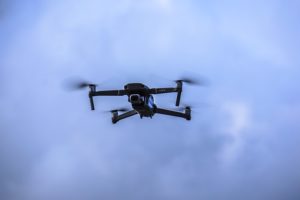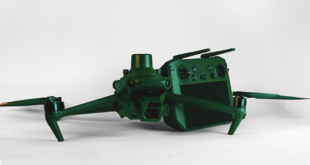As quarantines, shutdowns, and social distancing regulations are implemented around the globe to deal with the current pandemic, drone companies are stepping up to do what they can. Drones are an ideal tool to keep business going despite social distancing measures – but service providers say that they could do much more. Read on for a deep dive on how the drone industry is participating in response to current global challenges; and what needs to happen next.
The following is a guest post by Grant J. Guillot, who leads the Unmanned Aircraft Systems practice at the regional law firm of Adams and Reese LLP. DRONELIFE neither accepts nor makes payment for guest posts.
Ken Hanes, Owner of AGL Drone Services, was driving from Colorado Springs to Denver to perform UAS inspections when he turned on the radio and learned that the Mayor of Denver issued an order closing down bars and restaurants to fight the spread of COVID19. He then learned that Colorado Springs had declared a state of emergency and that the governor had ordered statewide closures to limit group gatherings. “Before COVID19, I’d never heard of social distancing, but it’s now part of my daily vocabulary and has found a place in my drone business,” Hanes says. “I realized on that drive to Denver to shoot those drone jobs that I practice social distancing every day in my business but didn’t realize it. My job allows me the unique opportunity to provide information to my clients with absolutely no face-to-face interaction. I have the ability to travel to a location and fly the drone to collect the information I need without ever interfacing with anyone, and the electronic deliverables I provide allows unlimited distribution to interested parties anywhere in the world.”
Hanes reflects on what many in the commercial drone industry have realized – drones are ideal for facilitating social distancing and have significant potential to assist with the public safety and economic impacts of COVID19. As explained by Luke Fox, Founder and CEO of WhiteFox Defense Technologies, “Drones are critical in the fight against COVID-19. This technology can work as a force multiplier to ensure people get medical supplies, food, and other life-saving essentials all while minimizing potentially infectious human contact. As drones continue to take to the sky, WhiteFox is working to create a safe, trusted, and secure airspace.”
Government decision-makers, industry stakeholders, and drone organizations are collaborating to determine the extent to which drones can assist with relief efforts during the pandemic. “The Commercial Drone Alliance’s focus right now is ensuring that our member companies are able to assist the COVID-19 response in the same way that other companies are stepping up to do so,” explains Lisa Ellman, Executive Director of the Commercial Drone Alliance. “We are in conversations with relevant stakeholders to determine how commercial drones can safely and effectively be used to help those affected by the virus.” Ellman adds, “There are many use cases for drones that can aid the nation from delivering test kits to areas in need to delivering medical goods to quarantined individuals, and much more. UAS provide essential services that can mitigate the need for extensive human interaction and can expedite logistics, which could help prevent the spread of the disease and enhance efficiencies as personnel are forced to stay home.”
This collaborative spirit is also being demonstrated by business operating in the commercial drone industry. “Given how rapidly the COVID19 has taken priority for all of us, we realize finding ways to manage ongoing operations is going to be a differentiator for global organizations,” says Tom Walker, CEO of DroneUp. “Assurance is key in uncertain times. That is why DroneUp is functioning in conjunction with FAA regulatory precautions as we collaborate with state and local officials to ensure safety for all. We are prepared to ensure safety through our processes and with our professional network of drone operators for inspections of remote facilities, media capture, package delivery, safety management, security monitoring, situation awareness, and remote temperature readings.”
Similarly, Ken Stewart, CEO of AiRXOS, states, “AiRXOS is actively working with our global partners and customers to help support COVID19 efforts, and we stand ready to collaborate with the industry in any way necessary to help make a difference.”
“We want the response from the overall drone community to be one of competence, compliance, and safety. We firmly believe there is a role for drones to play in public emergencies, but that any response must include input from state and local governments and must factor in authoritative data from those local sources,” says Michael Healander, President and CEO at Airspace Link. The company has a strategic integration with Esri, whose mapping and data technology is used by more than 80% of local governments, which gives Airspace Link immediate access to local resources and rapid implementation. “In response to COVID19 needs, we are positioned to provide national support with our technology immediately. We can deploy AirHub for Government, our software, as part of a general Unmanned Aircraft System Traffic Management (UTM) strategy for delivery and help connect local government teams with delivery companies. We deploy a national, ground based risk assessment within days, as well as deploy and train local and state personnel on advisory input within a similar time frame.” Healander adds, “We’re also working with a leading health security organization to help develop maps that give officials a better understanding of the spread of COVID, at risk populations and the readiness of the health communities in terms of available facilities, materials and staff. We’re happy to do our part in supporting those on the front lines… and it gives us direct insight to what’s top of mind for them and where drones might be of value in response to COVID.”
Government and industry leaders are partnering to both enforce social distancing, a public safety measure, and to assist with the economic impacts of COVID19. In regards to social distancing, drone companies are finding ways to assist end users with limiting the number of individuals involved in operations. “Zephyr Drones is assisting contractors, property management companies and many others by using drones to map and document job sites to tag and identify current situations, tag valuable assets, monitor entrance and exits, perform inspections in order to keep the number of persons on site as essential as possible,” explains Charles Sterling, owner of Zephyr Drones. “This allows skilled workers to focus on the work at hand, keeps non trade workers remote to limit the number of social interactions on the job sites. Once data is collected and processed, the remote worker can login to a web based portal and review inspections and document job sites.”
Ariel Avitan, Co-Founder and Chief Commercial Officer of Percepto, says, “From the moment COVID19 started to affect our clients in terms of manpower, our deployed systems started to preform new operational and HSEC missions that were done manually beforehand. For now we see and increase of 15-45% in the number of autonomous missions done daily. From our conversation with our clients this is a due to the shortage of manpower on site and the need to keep the business running.”
In addition, the DRONERESPONDERS Public Safety Alliance, the world’s fastest growing non-profit program supporting public safety UAS, has initiated a COVID19 Task Force to learn, collaborate and share ways that drones may assist in the response to COVID19. “DRONERESPONDERS has reached out to and also having conversations with the FAA, EENA, Interpol,” says Charles Werner, the organization’s Director. “To date, we have learned that drones are being used for situational awareness to monitor and disperse large gatherings. For example, we have learned that the Police Department for the City of Chula Vista, California, through its Drones as First Responders program, recently added night vision cameras and will be exploring the addition of speakers to their drones if needed to disperse large gatherings. In addition, drones are being used to monitor vulnerable homeless populations in their communities, and, in China, drones have been used to spray disinfectant – though there is no validation on the effectiveness.” Werner adds that any organization interested in participating in the COVID19 Task Force is encouraged to reach out via e-mail at [email protected].
In a recent example of drones be utilized to disperse social gatherings, Christopher Todd, Executive Director of the Airborne International Response Team, says, “AIRT recently used drones to capture aerial imagery of hundreds of Miami area boaters defying social distancing mandates by anchoring near each other at sandbar near Haulover Inlet. AIRT worked with WPLG Local 10 ABC to air the footage which increased public outcry and spurned additional action by Miami-Dade Mayor to increase law enforcement to disperse these groups.”
In addition to promoting social distancing, drones are also be used to assist companies experiencing economic hardships arising from personnel shortages. “Aerial Data Fusion is currently prepping its UAV Fleet for a ‘Pandemic Disruption Assault’,” says Lane Veillon, Owner and Chief Pilot at Aerial Data Fusion. “We have acquired extra support equipment and supplies to perform inspections that will greatly reduce the amount of personnel normally required during a very scary time that our entire country is going through currently. Most Importantly, ADF has already received approval to travel and perform this critical type of work during the pandemic.” Veillon adds, “The current pandemic should serve as the ultimate Proof of Concept for sUAS in Oil & Gas, Chemical, Power and many industries that absolutely can’t allow a long disruption in service or compromise site safety by delaying outages. ADF is ready, available and fully capable to perform a detailed confined space inspection or a simple external inspection of a business’ critical process assets that are normally performed by employees who may be under quarantine. We also have the ability to securely broadcast or deliver the data from these inspections to the site or anyone that may be quarantined at home that can approve the inspection data & observations.”
Adam Zayor, CEO of FlyGuys, says, “During the COVID19 crisis FlyGuys stands ready to help in any way. In certain instances, our pilots can operate independently thereby minimizing the risk of exposure while continuing to perform critical inspections for companies that would otherwise not be able to. FlyGuys stands ready to gather critical aerial data for the government and industry anywhere in the nation.”
Kyle Powroznyk, CEO of ProREPP Aerial Solutions, adds, “At ProREPP we realize that we are not just in the business of providing excellent service to our customers, but that we are also in the business of being a partner to our clients. During the unstable economic times resulting from COVID19 virus ProREPP is here to help businesses be as efficient and as cost effective as possible on job sites and in operations.”
Some companies are even offering end users discounted services to ease the economic strain of COVID19. “We are giving credits to co-ops that can’t afford the drone work right now so they can pay us next year or whenever they are in a financial secure position,” says “Jason Holt, President at Stone House Drone Institute. “A shortage of manpower is coming, and we have already been communicating with companies about obtain emergency beyond line of sight approval. We are here to help support our co-ops and line crews in any way possible. We can seriously cut down their hiking time tremendously to assess broken lines, check on outage causes, and other similar functions.”
While drones can assist with various functions during this challenging time for our country, there has perhaps never been a better time to implement drone deliveries which, by definition, employ social distancing to achieve distribution of consumer goods, medical supplies, and other items. “At Zing we are building a no-contact delivery system for use around the globe with standard DJI drones,” says Ian Annase, Founder and CEO at Zing. “The primary form of spread with COVID19 is through air particles and drone delivery is a highly effective tool for social distancing.”
“The pandemic shows that drone delivery is not a luxury—it’s a necessity,” says Jacob Ruytenbeek, Director of Government Affairs at AirMap. “With a robust UTM system in place, food delivery, package delivery, and even some emergency services could be accomplished by drone, allowing our economy to continue functioning while limiting human-to-human contact. We need to accelerate efforts to implement a UTM system so we can advance drone operations that best serve society during this time.”
However, regulatory hurdles and public perception issues remain impediments to advanced operations. Dawn Zoldi, CEO of P3 Tech Consulting,* an internationally renowned drone law and policy expert and 2019 Woman to Watch for her thought leadership in this arena, recognizes these predicaments and agrees with the value-proposition that drones bring to pandemic response and to life while in lockdown. “Drones are always force multipliers, and even more so now. I come at any problem through the lens of a 27-year Air Force veteran attorney who advised commanders on operations and think: ‘How can we enable the mission?’ It seems to me that the current mission is keeping folks alive through social distancing. As colleagues in MarketScale’s COVID-19 episode of “Drones in America” and in this article have stated, UAS can help us do that. Let’s break through the barriers that inhibit full UAS employment now — not next year or during the next pandemic. If there were ever a time to relook at policies that stand in the way, it’s now – even on an emergency or temporary basis.”
Skip Fredericks, two-time Emmy nominated content producer, certified drone instructor, and Founder of Hollywood Drones, echoes that sentiment. “Forget all the white papers work studies, we know drones work, they can be used for security, surveillance and deliveries,” Fredericks says. “They can be outfitted with Thermal Cameras that can detect those who are infected, they can quickly deliver light weight supplies to portable medical sites and testing centers.” Fredericks adds, “We don’t need to wait for any custom made drones or high end one-offs that can cost $10,000s. Thousands of DJI and Autel Drones are in the hands of very capable pilots ready and able to help. The current administration needs to tear up their ridiculous ban on using Chinese-made drones and let those companies that have those drones and the rest of us get to work, help the public and make a living along the way. When you see the rest of the world using drones in the way I mentioned above, it’s just sad that ‘we’ can’t do the same thing here, when so many of us want to help.”
Commenting on the public perception issues surrounding commercial drones use in the United States, Frank Segarra, President and CEO of ConnexiCore poses the question, “How do we in the UAS industry reconcile the fear of drones roaming our skies while new fears are arising from the COVID-19 pandemic? The public has heard for the last few years that drones are ideal for areas that replace work that’s dirty, dangerous and repetitious.” Segarra adds, “Using drones for social distancing right now would actually be an ideal way of doing that in numerous industrial markets. During this period, both the drone industry and businesses will gain further awareness of how drones can make a real difference in numerous workflow scenarios. The current situation means businesses need to start embracing and changing company practices, aligning with new technologies, having employees telecommute, and canceling any large meetings. I think the need versus the methodology is what we’ll be learning and helping us plan for what comes next.”
In conclusion, while the commercial drone industry has long known that UAS will play a significant role in everyday operations for many Americans, the industry could not have foreseen the recent events that have made the integration of drones into the U.S. airspace an immediate necessity. As noted by Hanes, “I never imagined that keeping our distance from one another would be the solution to a problem this big, but it seems that it is. In this strange time of our lives, it feels great to be able to offer something that can help the fight.”
To learn more about how drones are helping combat COVID-19, tune in to MarketScale’s “Drones in America” podcast, where I am joined by AiRXOS’ Ken Stewart, AIRT’s Christopher Todd, and DRONERESPONDERS’ Charles Werner to discuss the potential for drones to assist with the effects of this pandemic.
Additionally, if you want to learn more about drone law and policy, this year, the 6th Edition of Commercial UAV EXPO Americas 2020 is hosting a first-of-its-kind one day Law-Tech Connect CLE Workshop on September 15th, to parallel and leverage the companion Commercial UAV Americas program at the Paris Hotel in Las Vegas. Law-Tech Connect is a P3 Tech Consulting continuing legal education (CLE) program, non-financially co-sponsored by the American Bar Association Science & Technology Law Section, focused on U.S. and global legal, regulatory, policy, and ethical issues related to advanced technologies, with an emphasis on drones and advanced tech. Topics will include: federal/state/local/tribal/global regulations, privacy, security, contracts and business law, artificial intelligence, autonomy and a special personal wellness session geared towards innovation practitioners. CLE credit will be available to attorneys. The event, however, is open to anyone who is interested in how the law will shape the future of drones in the U.S. and globally.
*The views and opinions in this article are those of the author and do not reflect those of the DOD, do not constitute endorsement of any organization mentioned herein and are not intended to influence the action of federal agencies or their employees.
 Grant J. Guillot leads the Unmanned Aircraft Systems practice at the regional law firm of Adams and Reese LLP. He advises companies that provide drone/unmanned aircraft system (UAS) services, as well as companies operating in industries that are increasingly using drones, such as construction, energy/oil & gas, forestry and agriculture, insurance, public safety, telecommunications, and transportation & logistics. He regularly represents clients in contractual matters between UAS companies and businesses seeking to retain UAS operators. Grant assists commercial drone users with the concurrent navigation of federal, state and local UAS regulations. He also advocates on behalf of businesses and trade associations before legislative and executive decision makers at the state and local levels to promote a favorable and effective regulatory environment for UAS operations. In addition, Grant assists businesses with crafting and implementing strategies to achieve maximum cost efficiency and risk reduction through the use of UAS. He has written several articles that have been published and presented at various seminars regarding matters pertaining to commercial drone utilization.
Grant J. Guillot leads the Unmanned Aircraft Systems practice at the regional law firm of Adams and Reese LLP. He advises companies that provide drone/unmanned aircraft system (UAS) services, as well as companies operating in industries that are increasingly using drones, such as construction, energy/oil & gas, forestry and agriculture, insurance, public safety, telecommunications, and transportation & logistics. He regularly represents clients in contractual matters between UAS companies and businesses seeking to retain UAS operators. Grant assists commercial drone users with the concurrent navigation of federal, state and local UAS regulations. He also advocates on behalf of businesses and trade associations before legislative and executive decision makers at the state and local levels to promote a favorable and effective regulatory environment for UAS operations. In addition, Grant assists businesses with crafting and implementing strategies to achieve maximum cost efficiency and risk reduction through the use of UAS. He has written several articles that have been published and presented at various seminars regarding matters pertaining to commercial drone utilization.
Grant earned his J.D. and Graduate Diploma of Civil Law magna cum laude from Louisiana State University’s Paul M. Hebert Law Center, where he was selected to join the Louisiana Law Review and inducted into the Order of the Coif for graduating in the top 10 percent of his class. He earned his B.A. in Mass Communications with a Minor in Business Administration summa cum laude from Louisiana State University, graduating first in his college class and participating in the Honors College program. Upon graduating from law school, Grant served a one-year term as a judicial law clerk for the Honorable Chief Justice Catherine D. “Kitty” Kimball of the Louisiana Supreme Court.
Miriam McNabb is the Editor-in-Chief of DRONELIFE and CEO of JobForDrones, a professional drone services marketplace, and a fascinated observer of the emerging drone industry and the regulatory environment for drones. Miriam has a degree from the University of Chicago and over 20 years of experience in high tech sales and marketing for new technologies.
For drone industry consulting or writing, Email Miriam or (for paid consulting engagements only) request a meeting through AdvisoryCloud:
TWITTER:@spaldingbarker
Subscribe to DroneLife here.
https://dronelife.com/2020/03/24/drones-are-the-ideal-tool-for-keeping-the-economy-moving-despite-social-distancing-heres-how/
 Unmanned Aerial Vehicle The latest drone news
Unmanned Aerial Vehicle The latest drone news





